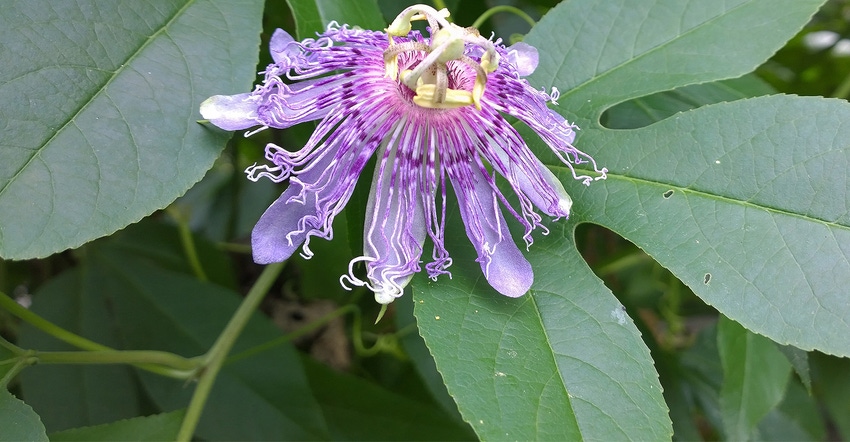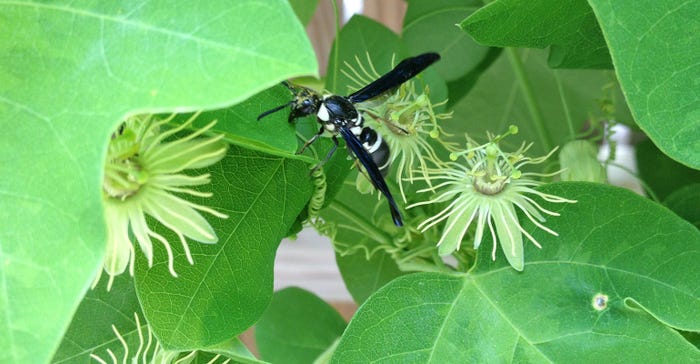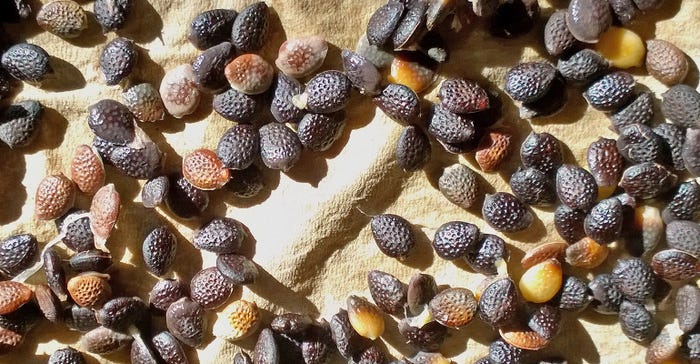September 28, 2018

Rarely are there Missouri native plants with flowers and fruit so exotic and beautiful that they seem to belong on a make-believe movie set. Both the yellow passion flower and maypop look more like a home for fish swimming in a coral reef than they do a native plant in a Missouri woodland.
While both are unique flowers, they have quite different sizes and colors.
Tiny treasure
The yellow passion flower is often overlooked in the wild because it is tiny. Three-quarter-inch pale yellow flowers appear in late summer scattered along the stem and are easily missed unless you are looking for them. New flowers emerge at the end of the stem as it grows and keeps blooming into fall.
 SEARCH AND FIND: You may need to look a little harder to find the yellow passion flower. It is smaller than its counterpart-maypop-but still offers a different look for any native garden.
SEARCH AND FIND: You may need to look a little harder to find the yellow passion flower. It is smaller than its counterpart-maypop-but still offers a different look for any native garden.

With the yellow passion flower, clump-forming stems may grow only 5- to 10-feet long with tiny tendrils, leaves and flowers. The vines disappear when rambling among other plants. It becomes more noticeable if you train this flower on a post or trellis. The leaves are variable but may have an interesting blotchy dark and light green pattern that resembles a pickerel frog.
In autumn, the half-inch dark purple fruits ripen into showy, inedible juicy fruits. Unlike the fruit of maypops, these berries leave a bad taste in the mouth.
Flashy flower
Maypops stand out in the garden and are incredibly showy, like a lavender sea anemone. The 3-inch flowers dazzle the eye with burgundy speckles, ruby tentacles, wavy lavender tendrils, a purple bullseye pattern and a lime-green center. Worldwide there are 520 species of passion flower; Missouri is home to two of them. The plants are native in the Bootheel with a few scattered populations further north.
 EDIBLE TREAT: Fruit from the maypop can be pressed and used for salad dressing or in juices.
EDIBLE TREAT: Fruit from the maypop can be pressed and used for salad dressing or in juices.

The maypop is a late-summer blooming passion flower. It has a moderately aggressive tendency to sucker, which is a turn-off to some gardeners. But if you are going for a natural look, this might be a great plant for you.
Maypops sprout from the ground very late in spring with random stems 3 to 5 feet apart. These stems come up between other plants and may not appear in the same place from year to year. Although it has a habit of rambling when grown in the ground, it is easily kept in control in a large container (24-inch diameter or larger) trained up on a trellis. Plants are hardy outdoors and are perennial, though the leaves, stems and fruits are sensitive to hard frosts.
Fruits of the flower
Maypops fruit are incredibly delicious, but only when they fully ripen.
Most years the plants are hit by a hard frost before attaining maturity, and the incredible flavor never develops. Every few years, however, when frost comes late, the egg-like fruits turn yellowish and the pulp inside gets juicy, with an amazing balance of sweet and sour and a flavor like guava.
Like all great things in life, there is a downside: the seeds are large and crunchy in an unpleasant way. Run the pulp through a Foley’s food mill to remove the seeds, then strain through a fine sieve to remove the pulp and you are left with a yummy juice to drink straight up or to dress a salad.
Happy gardening and dining!
Woodbury is a horticulturalist and the curator of the Whitmire Wildflower Garden at Shaw Nature Reserve in Gray Summit, Mo., and an adviser to the Missouri Prairie Foundation’s Grow Native! program.
About the Author(s)
You May Also Like




